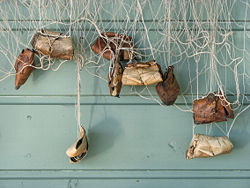Birch bark

Birch bark or birchbark is usually the bark of the paper birch tree or sometimes of similar trees such as gray (wire) birch.
Birch bark is useful because it is strong and water-resistant. It is similar in some ways to cardboard. And can be easily cut, bent and sewn. Because of this it has been very valuable for building, crafting, and writing material ever since ancient times. Birch bark also contains substances that are used in medicines and chemicals.
Uses
Birch bark was valuable throughout the world where birch trees were available:
- In North America, the native people used birch bark for canoes and wigwams and more.
- In Scandinavia and Finland, it had many uses, including roofs, boxes, casks and buckets.
- In Russia, many birch bark documents have survived from the Middle Ages.
- In the Indian civilisation birch-bark, along with dried palm leaves, replaced parchment for writing.
Birch bark is can also be used as a tinder. It is very good tinder as the inner layers will stay dry even through heavy rainstorms. To make birch bark useless as tinder, it must be soaked in water for a very long time.
Birch Bark Media
A birch bark longhouse on Whitefish Island in Canada
North American birchbark canoe
References
- The Algonquin Birchbark Canoe by David Gidmark Archived 2005-02-13 at the Wayback Machine.
Other websites
| Wikimedia Commons has media related to Lua error in Module:Commons_link at line 62: attempt to index field 'wikibase' (a nil value).. |
- The Birch Bark Torch Archived 2012-02-06 at the Wayback Machine, a Wilderness Way Magazine's article by Kevin Finney.
- Birchbark articles from the NativeTech site.
- Birch and Birch BarkArchived 2012-02-05 at the Wayback Machine, an article by John Zasada at an University of Minnesota site.
- Birch Bark Canoe Building Courses at the North House Folk School, Minnesota.
- Birch Bark Canoe Archived 2007-06-07 at the Wayback Machine page on the site of the Algonquins of Pikwàganagàn.






